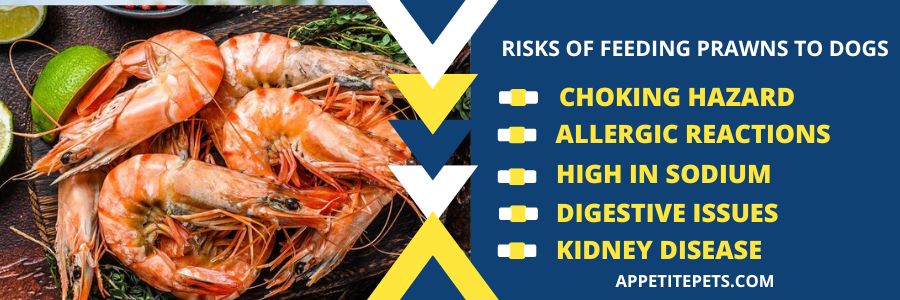Can Dogs Eat Prawns? The Ultimate Guide for Dog Owners
Wondering Can dogs eat prawns? The benefits, risks, and necessary precautions of feeding prawns to your pet friend are all discussed in detail in this detailed guide.
You, the pet owner, probably know that your dog can’t eat everything you eat. Toxic and even fatal reactions to certain foods are possible.
Thus, it is crucial to exercise caution when providing food for your furry friend. Prawns are one such food that can cause consternation among dog owners.
Can Dogs Eat Prawns?
It’s true that prawns are dog-friendly. Prawns are a nutritious addition to your dog’s diet because they contain protein, omega-3 fatty acids, and necessary vitamins and minerals.
If you’re concerned about dogs’ stomachs reacting negatively to prawns, like with any novel food, it’s best to ease into eating them.
Benefits of Feeding Prawns to Dogs:
Feeding shrimp to your dog could provide several medical benefits, including:
Prawns are packed with muscle-building and repair-critical nutrient protein.
Prawns are an excellent source of omega-3 fatty acids, which can help your dog’s skin and coat, as well as reduce inflammation and strengthen his immune system.

Nutritionally, prawns are a good choice because they provide essential vitamins and minerals, including B12, E, zinc, copper, and selenium.
Risks of Feeding Prawns to Dogs:
While prawns are generally safe for dogs to eat, there are some risks associated with feeding them:
Choking Hazard: Prawns have hard shells that can pose a choking hazard to dogs, especially small dogs. Always remove the shell before feeding prawns to your dog.
Allergic Reactions: Some dogs may be allergic to prawns, which can cause symptoms such as itching, hives, and difficulty breathing. If your dog shows any signs of an allergic reaction, stop feeding prawns immediately and consult your veterinarian.

High in Sodium: Prawns can be high in sodium, which can be problematic for dogs with certain health conditions such as kidney disease. Therefore, it’s important to limit the number of prawns you feed your dog.
Precautions to Take:
Here are a few things to keep in mind before feeding prawns to your dog:
To avoid gastrointestinal discomfort, prawns should be introduced slowly and in small amounts.
If you want to avoid your dog choking on the shell, you should never feed it whole prawns.
In order to kill off any bacteria that might be present in raw prawns, it is best to cook them deeply before feeding them to your dog.
Prawns should not be fed if they have been seasoned or cooked with garlic, onions, or any other ingredients that can be harmful to dogs.
If your dog has any health conditions or allergies, your vet will be the best person to advise you on whether or not prawns are safe for your dog to eat.
FAQs:
Q: Can dogs eat cooked prawns?
A: Yes, dogs can eat cooked prawns as long as the shells are removed, and the prawns are not seasoned with any toxic ingredients.
Q: Can dogs eat prawns with tails?
A: No, it’s best to remove the tail before feeding prawns to your dog to avoid choking hazards.
Q: How many prawns can I feed my dog?
Your dog’s weight, age, and general health will determine how many prawns it can safely eat. Prawns are great as a special treat for your dog, but they shouldn’t be a regular part of their diet.
A dog can safely consume a small number of prawns once or twice weekly to reap the health benefits.
Q: Can prawns cause diarrhea in dogs?
If given in large quantities or to a dog with a sensitive stomach, prawns can cause diarrhea. To prevent gastrointestinal discomfort, prawns should be introduced slowly and in small amounts.
Q: Can puppies eat prawns?
Prawns are safe for puppies to eat, but they should be introduced to them slowly and in small amounts to prevent stomach upset. Puppies’ digestive systems are still developing, so they may have trouble digesting new foods.
When deciding how many prawns to feed your puppy, it’s important to think about their size and general health.
Q: Are prawns high in cholesterol?
Prawns, like other seafood, are high in cholesterol, which can be dangerous for dogs with conditions like heart disease. Consequently, you should restrict the number of prawns your dog consumes.
Conclusion:
Ultimately, prawns are safe for dogs to eat if they are cooked, and unsalted, and the shells are removed to prevent choking. Dogs can benefit from eating prawns because they are full of protein, omega-3 fatty acids, and vitamins and minerals.
While prawns can be a healthy addition to your dog’s diet, they should be introduced slowly and in moderation to prevent gastrointestinal upset.
You should also remove the shell and check with your vet if your dog has any health conditions or allergies. If you follow these rules, prawns can be a healthy treat for your dog on occasion.
Q: Can prawns cause allergic reactions in dogs?
Some dogs, unfortunately, are sensitive to shellfish like prawns. Allergic reactions can manifest as a wide range of symptoms, including itching, swelling, nausea, vomiting, and even difficulty breathing.
Veterinarians recommend avoiding prawns if your dog has ever shown signs of an allergy and avoiding them altogether if you know or suspect they are allergic.
Q: Can dogs eat prawns with shells on?
The short answer is no, you shouldn’t give your dog prawns with the shells still on. If swallowed, the shell can cause serious gastrointestinal problems and even death.
When feeding prawns to your dog, make sure to peel off the shell first.

Q: Are there any health risks associated with feeding dogs prawns?
Prawns have both positive and negative effects on a dog’s health. Due to their cholesterol content, prawns may not be suitable for dogs with heart disease.
In addition, prawns may harbor bacteria like salmonella which is toxic to dogs. Care must be taken to reduce the potential for illness by properly preparing and storing the prawns.
Q: How should I prepare prawns for my dog?
For your dog’s health, always make sure their prawns are fully cooked and seasoned-free. The shell and any other potential choking hazards must be removed.
In addition, prawns are best served as a special treat on their own, rather than in a dish with other ingredients.




